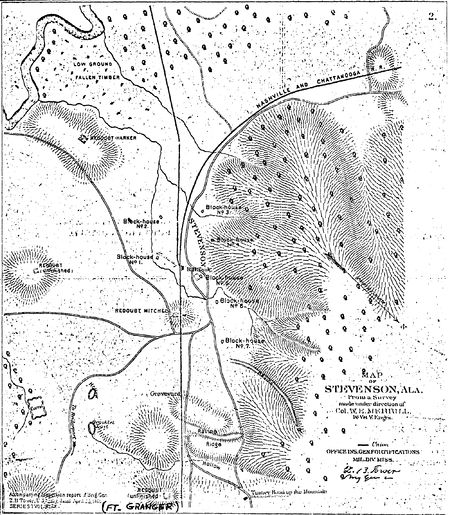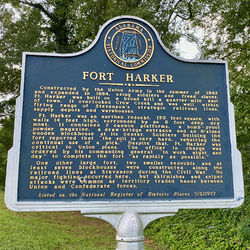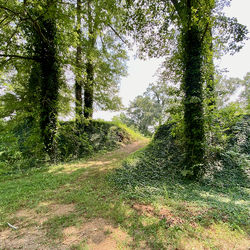Fort Harker (3): Difference between revisions
John Stanton (talk | contribs) No edit summary |
John Stanton (talk | contribs) No edit summary |
||
| (13 intermediate revisions by the same user not shown) | |||
| Line 2: | Line 2: | ||
{{SocialNetworks}} | {{SocialNetworks}} | ||
'''{{PAGENAME}}''' (1862-1865) - A Union [[U.S. Civil War]] Fort established in 1862 near Stevenson, Jackson County, Alabama. Named Fort Harker | '''{{PAGENAME}}''' (1862-1865) - A Union [[U.S. Civil War]] Fort established in 1862 near Stevenson, Jackson County, Alabama. Named Fort Harker after Colonel [[Charles G. Harker]], 65th Ohio Infantry, who served under Brigadier General [[Don Carlos Buell]], {{Cullum|1090}}. Union General [[William Rosecrans]], {{Cullum|1115}}, established his headquarters at Fort Harker in July 1863, and from here he directed a successful campaign against Confederate General [[Braxton Bragg]], {{Cullum|895}}, in Chattanooga, Tennessee. The fort was abandoned in 1865 after the end of the war. | ||
{|{{FWpicframe}} | {|{{FWpicframe}} | ||
| Line 9: | Line 9: | ||
|width="50%"|<!--[[Image:.jpg|350px|thumb|right|Fort Harker (3)]]--> | |width="50%"|<!--[[Image:.jpg|350px|thumb|right|Fort Harker (3)]]--> | ||
|- | |- | ||
|colspan="2"|[[File:Fort Harker AL 1862.jpeg|795px|thumb|center|Fort Harker, Alabama in 1862.]] | |colspan="2"|[[File:Fort Harker AL 1862.jpeg|795px|thumb|center|Fort Harker, Alabama in 1862. This appears to be a view of the northwest bastion.]] | ||
|- | |||
|colspan="2"|[[File:Fort Harker NE Bastion.jpeg|795px|thumb|center|Fort Harker NE Bastion in 2021.]] | |||
|} | |} | ||
== History == | == History == | ||
Constructed by the Union Army in the summer of 1862 and expanded in 1864, using soldiers and freed slaves, Fort Harker was one of three named forts and some seven blockhouses built to protect a strategic rail junction at Stevenson, Alabama. The fort itself overlooked Crow Creek and was within firing range of the railroad lines, supply depots, and warehouses. | Constructed by the Union Army in the summer of 1862 and expanded in 1864, using soldiers and freed slaves, Fort Harker was one of three named forts and some seven blockhouses built to protect a strategic rail junction at Stevenson, Alabama. The fort itself overlooked Crow Creek and was within firing range of the railroad lines, supply depots, and warehouses. | ||
[[File:Stevenson AL Fortifications.jpeg|thumb|right|450px|Stevenson Alabama Civil War Fortifications]] | |||
Fort Harker was built as a packed earth redoubt, 150 feet square, with walls 14 feet high, surrounded by an 8 foot deep dry ditch. It contained 7 cannon platforms, a bomb-proof keep, a powder magazine, a draw-bridge entrance, and an 8-sided wooden blockhouse at its center. | Fort Harker was built as a packed earth redoubt, 150 feet square, with walls 14 feet high, surrounded by an 8 foot deep dry ditch. It contained 7 cannon platforms, a bomb-proof keep, a powder magazine, a draw-bridge entrance, and an 8-sided wooden blockhouse at its center. | ||
| Line 19: | Line 21: | ||
The second large fort, [[Fort Mitchell (5)|Fort Mitchell]], two smaller redoubts and at least seven blockhouses were constructed along the railroad lines at Stevenson. [[Fort Granger (2)|Fort Granger]] was the third fort and it remained serviceable but partially incomplete at the war's end. | The second large fort, [[Fort Mitchell (5)|Fort Mitchell]], two smaller redoubts and at least seven blockhouses were constructed along the railroad lines at Stevenson. [[Fort Granger (2)|Fort Granger]] was the third fort and it remained serviceable but partially incomplete at the war's end. | ||
The defenses at Stevenson were strong but forts Harker and Mitchell were attacked on 31 Aug 1862 by Confederate | The defenses at Stevenson were strong but forts Harker and Mitchell were attacked on 31 Aug 1862 by Confederate General [[Samuel Jones]], {{Cullum|1077}}, with some 1,000 soldiers. The greatly outnumbered federal forces were compelled to retreat, leaving behind several pieces of artillery and great quantities of supplies. General Jones telegraphed his superiors that he saw 200 wagons departing Stevenson loaded with goods and fleeing troops. Union forces reoccupied the town and forts after General Jones and his troops departed. | ||
Fort Harker was abandoned in 1865 after the end of the war. | |||
{{Clr}} | |||
== Current Status == | == Current Status == | ||
[[File:Fort Harker Marker.jpeg|thumb|left|250px|Fort Harker On-Site Marker.]] | |||
[[File:Fort Harker Entrance.jpeg|right|250px|Fort Harker Entrance.]] | |||
Four of the gun platforms are still in evidence. A National Park Service excavation in 1976 uncovered a wooden tank in one corner, probably a reservoir for the fort. The fort was listed on the National Register of Historic Places 2 May 1977, #77000205. A historical marker has been placed at the fort site by the Alabama Historical Commission. | Four of the gun platforms are still in evidence. A National Park Service excavation in 1976 uncovered a wooden tank in one corner, probably a reservoir for the fort. The fort was listed on the National Register of Historic Places 2 May 1977, #77000205. A historical marker has been placed at the fort site by the Alabama Historical Commission. | ||
[[File:Fort Harker Interior.jpeg|thumb|center|800px|Fort Harker Interior.]] | |||
{{Clr}} | |||
---- | ---- | ||
{| | {| | ||
| Line 48: | Line 57: | ||
* {{Roberts}}, page 6. | * {{Roberts}}, page 6. | ||
* [https://archive.org/details/photographichist02mill/page/n171/mode/1up?view=theater The photographic history of the Civil War.] | * [https://archive.org/details/photographichist02mill/page/n171/mode/1up?view=theater The photographic history of the Civil War.] | ||
* [https://npgallery.nps.gov/GetAsset/51b4a59c-86f7-4d39-8d35-5e452687797e NPS - National Register Of Historic Places Inventory Nomination Form - Stevenson Historic District] | |||
* Official Records, vol. 16, pt. 2, p. 952. | |||
'''Links:''' | '''Links:''' | ||
* [https://www.northamericanforts.com/East/alnorth.html#stevenson North American Forts - Fort Harker (3)] | * [https://www.northamericanforts.com/East/alnorth.html#stevenson North American Forts - Fort Harker (3)] | ||
* [https://en.wikipedia.org/wiki/Fort_Harker_(Alabama) Wikipedia - Fort Harker (3)] | * [https://en.wikipedia.org/wiki/Fort_Harker_(Alabama) Wikipedia - Fort Harker (3)] | ||
* [http://www.cityofstevensonalabama.com/Depot-Museum.html City of Stevenson] | * [http://www.cityofstevensonalabama.com/Depot-Museum.html City of Stevenson] | ||
{{Visited| | |||
{{Visited|3 Aug 2021}} | |||
__NOTOC__ | __NOTOC__ | ||
| Line 63: | Line 76: | ||
[[Category:Alabama Jackson County]] | [[Category:Alabama Jackson County]] | ||
[[Category:{{PAGENAME}}]] | [[Category:{{PAGENAME}}]] | ||
[[Category:Starter Page]] | [[Category:Starter Page]] | ||
[[Category:U.S. Civil War Forts]] | [[Category:U.S. Civil War Forts]] | ||
[[Category:2021 Research Trip]] | |||
Latest revision as of 16:44, 5 August 2021
|
HistoryConstructed by the Union Army in the summer of 1862 and expanded in 1864, using soldiers and freed slaves, Fort Harker was one of three named forts and some seven blockhouses built to protect a strategic rail junction at Stevenson, Alabama. The fort itself overlooked Crow Creek and was within firing range of the railroad lines, supply depots, and warehouses.  Fort Harker was built as a packed earth redoubt, 150 feet square, with walls 14 feet high, surrounded by an 8 foot deep dry ditch. It contained 7 cannon platforms, a bomb-proof keep, a powder magazine, a draw-bridge entrance, and an 8-sided wooden blockhouse at its center. The second large fort, Fort Mitchell, two smaller redoubts and at least seven blockhouses were constructed along the railroad lines at Stevenson. Fort Granger was the third fort and it remained serviceable but partially incomplete at the war's end. The defenses at Stevenson were strong but forts Harker and Mitchell were attacked on 31 Aug 1862 by Confederate General Samuel Jones, (Cullum 1077), with some 1,000 soldiers. The greatly outnumbered federal forces were compelled to retreat, leaving behind several pieces of artillery and great quantities of supplies. General Jones telegraphed his superiors that he saw 200 wagons departing Stevenson loaded with goods and fleeing troops. Union forces reoccupied the town and forts after General Jones and his troops departed. Fort Harker was abandoned in 1865 after the end of the war.
Current Status  Four of the gun platforms are still in evidence. A National Park Service excavation in 1976 uncovered a wooden tank in one corner, probably a reservoir for the fort. The fort was listed on the National Register of Historic Places 2 May 1977, #77000205. A historical marker has been placed at the fort site by the Alabama Historical Commission. 
See Also: Sources:
Links: Visited: 3 Aug 2021
| |||||||||

